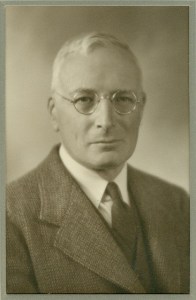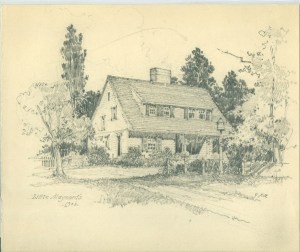George Francis Marlowe (1877 – 1955) was born in Norwood, England on March 30, 1877. During his childhood, the family moved to Worcester, Massachusetts. After graduating from Worcester High School, George attended the Massachusetts Institute of Technology (MIT) in Cambridge where he studied architecture, drawing and painting.

On July 28, 1909, George married Diantha Williams Horne (1879-1966), a children’s book illustrator from Framingham, Massachusetts. The couple moved into a home designed by George at 198 Maynard Road, and called the English garden style house “Little Maynard”. The house is still standing there today.
Early in his career, he worked for two Boston architectural firms, Peabody and Stearns, and Andres, Jacques, and Rantoul. It was during this period that he designed two buildings for Wellesley College: Hallowell House and Horton House.
In 1922, Marlowe was hired by Babson Institute (Babson College today). While an employee of Babson, he designed ten buildings for the campus. After Park Manor, the last of the ten, was completed in 1930, he resigned from the college and went to work full time in a private architectural firm which he had established in 1928. Between 1928 and 1938, he worked on many projects including several local ones: St. Andrew’s Church, the expansion of Framingham High School (Union Avenue), the Edgell Memorial Library (Edgell Road) in Framingham, and the Walnut School in Natick.

Marlowe was involved in many local organizations. In addition to being a member of the Society for the Preservation of New England Antiquities, The Boston Society of Architects, and the American Institute of Architects, he was also a member and president (1932-1942) of the Framingham Historical and Natural History Society and a trustee for the Edgell Memorial Library.
In the 1940s and 1950s, Marlowe authored several books on the cultural history of New England. In them, he highlighted the churches, inns, villages, and roads throughout the region. He illustrated these with pencil sketches and photographs taken during his travels.
George F. Marlowe died on April 30, 1955 and is buried in the Edgell Grove Cemetery in Framingham Centre.
Bibliography
Marlowe, Diantha Williams Horne. Dedication in Devoted Memory of George Francis Marlowe, 1877- 1955. Privately printed. State Historical Company, 1957.
Rybnikar, R. C. “George Francis Marlowe, Jr.” Babson College History, Blog Spot. 21 July 2009. http://babsonhistory.blogspot.com/2009/07/george-francis-marlowe-jr.html Accessed 05 Apr. 2017.